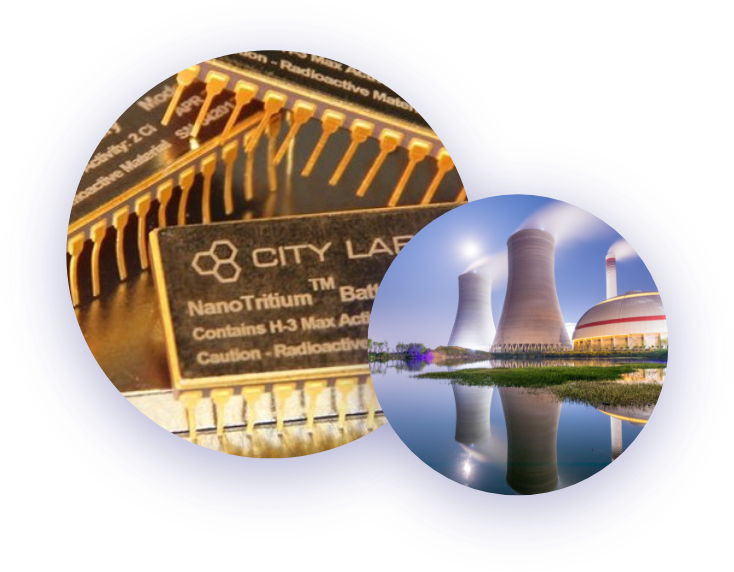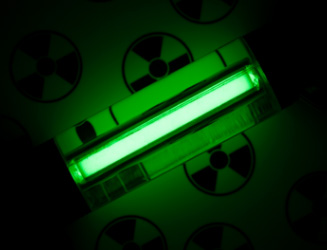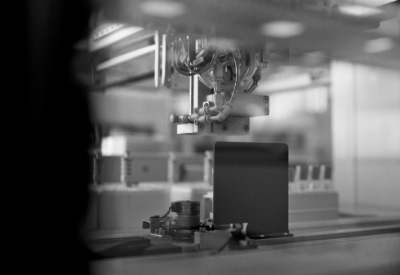
What Is a Nuclear Battery?
Scientists have been studying the potential capabilities of nuclear power for decades; figuring out how to store that energy in a diminutive space has been challenging. Certain radioactive isotopes are volatile, toxic, difficult to shield, and unsuitable for use as part of a direct conversion power source.
But other isotopes are relatively benign and have the potential to power remote electronics for extensive periods of time. Using radioisotopes like tritium, scientists and engineers have begun creating practical nuclear batteries for powering low-energy devices.
A nuclear battery is any device that harnesses energy from radioactive element isotope decay to generate electricity. Nuclear battery, atomic battery, and radioisotope generator are interchangeable terms that indicate how the power source creates a current.


How Are Nuclear Batteries Different?
Nuclear batteries differ from traditional batteries in their cost, lifespan, applications, and function.
Traditional batteries use electrochemical reactions as their power supply. Radioisotope generators capitalize on the decay of radioactive alpha, beta, and gamma particles to provide a constant energy source. As these particles are emitted, they stir electrons in the battery system to create a current.
Due to the increased capabilities of nuclear batteries, they are much more expensive than a traditional battery of the same size. This is one of the limitations that currently exists with nuclear battery research and use.
How Do Atomic Batteries Work?
Atomic and nuclear batteries generate electricity through the decay of radioactive particles. Some batteries use this decay to generate heat and then harvest with thermocouples; others harness diode junctions to facilitate non-thermal conversion. Regardless of the method, all nuclear batteries draw energy from a radioactive source.
Types of Nuclear Batteries
Different atomic batteries use different systems to generate power for their devices. Each type has its own benefits, limitations, and use cases. Understanding the differences between battery types can help you invest in the correct technology for your company.
Breakdown of Radioactive Elements for Battery Usage
The type of nuclear battery being used often depends on which radioactive isotope is acting as a power supply. There is a difference between the way energy from alpha particles, beta particles, and gamma rays is captured. Here are some of the more commonly used and tested radioactive isotopes.

Uranium Power
Uranium is a popular radioactive nuclear element for power supply because it has been used as the primary source of energy in nuclear power plants for over 60 years. Most plants use the uranium-235 isotope because its atoms are easier to break apart. Uranium can be mined as a solid and is considered weakly radioactive.
Uranium outputs weak alpha particles which cannot penetrate a piece of paper, and the half-life of uranium-235 is around 700 million years. Unfortunately, uranium-235 is not suitable to be used in batteries. As far as small-remote devices go, this isotope is out of the question.

Plutonium Batteries
One of the other more recognizable radioactive elements—plutonium—has already been used in nuclear batteries in the past. Isotope plutonium-238 has a half-life of 87.7 years and acted as a cardiac pacemaker power supply for a short time in the 1970s. There were two main issues with plutonium-238 batteries.
First, they were bigger than other batteries. The barriers needed to slow down plutonium radiation made the pacemakers inconvenient and unpleasant for those who had them.
Second, they were—in what would have been a worst case scenario—still very toxic to humans. If even a minuscule portion of the liquid in the battery had come into contact with someone’s bloodstream, they would have most likely died of radiation sickness.

Tritium Batteries
Tritium is an isotope of hydrogen found in the top layers of the atmosphere and artificially created as a by-product of some nuclear power plants. While it only has a half-life of 12.3 years, it is considered relatively benign and much more accessible than other isotopes.
As tritium breaks down, it releases beta particles that can be contained with barriers less than 1 millimeter thick depending on the material. CityLabs uses a barrier that effectively blocks the particles with less than one-tenth of that thickness.
This isotope is already being used and studied for further applications. Tritium offers a safe and reliable source for long-term, low-power electricity.
Nuclear Battery Applications
Atomic batteries are already being used in devices such as moon landers and satellites; RTGs are even helping to power the Perseverance Mars rover! As research continues to develop effective ways to harness and contain radioactive decay, the number of potential uses for radioisotope power sources will increase dramatically including wireless sensors, low power electronics, oil well monitoring, and other exciting applications.
Nuclear Batteries For Security Measures
Transitioning from the large-scale back to the small-scale capabilities of nuclear batteries, this technology has the potential to significantly improve security devices. Low-energy devices—such as sensors—that monitor threshold changes stand to benefit the most. In both outer space and deep underwater where replacement becomes more difficult, a battery that lasts several decades is invaluable.
When the surrounding environment undergoes certain changes, the sensors activate, sending a signal to the necessary parties.
Equipped with nuclear batteries, these sensors could help the military detect pressure alterations, temperature shifts, or vibrations indicative of unnatural occurrences. They could also help weather-forecasting organizations detect natural disasters at an earlier stage.
Thanks to CityLabs’ Power Source Package (PSP) patent, nuclear cybersecurity is becoming more realistic. We can hide a long-lasting power source directly on the circuit board of your device to help protect precious data from hackers and power encryption keys.
Additionally, nuclear batteries are already protecting nuclear waste from falling into the wrong hands by recycling hazardous materials.

Nuclear Battery Lifespan
One reason nuclear batteries are so promising is their predictability. As we continue discovering more about how to optimize the non-radioactive components of a power source, we are learning how to take advantage of its full lifespan.
Because the electricity comes from a steady decay of particles, the battery does not deplete faster because of increased usage. Studies of radioisotope half-life tendencies allow researchers to predict how much energy a nuclear battery can output at any period of time throughout its use.
Disadvantages Of Nuclear Batteries: Do Batteries Give Off Radiation?
In the past, humans did not have a good understanding of radiation—or strategies for handling it safely. One of the largest hurdles for nuclear battery manufacturers is the public’s negative perspective on nuclear energy. City Labs continues to address this issue by educating people on how clean nuclear energy can be eco-friendly, efficient, and safe with the use of tritium.
Nuclear Battery Cost
The cost of producing nuclear batteries is impractical for certain applications. Radioisotopes can be rare and the technology necessary to effectively utilize them can be expensive. Historically, nuclear battery prices have been too high to justify mass production and use.
With less demanding isotopes like tritium, the commercialization of these products has become more realistic. Products with tritium batteries will be more accessible and become less costly with wider adoption.
Applications Of City Labs’ NanoTritium™ Battery Technology
City Labs’ NanoTritium™ batteries are used to power a wide range of low-energy electronic devices. NanoTritium™ batteries are used in things like SRAMs to power encryption keys when the processors are powered down.
Our products can last over 20 years and are resistant to extreme temperature variance. These characteristics make our patented nuclear battery technology an ideal solution where chemical batteries are ineffective because of lifetime, temperature, or replaceability concerns. Our research and development team is constantly working to improve our products’ functionalities.
Ongoing Research And Development Of City Labs’ Batteries
Even though our team has developed successful batteries that can last for decades—some of which have been functional in customers’ hands since 2008—we are always striving to reach the next level of efficiency for our partners.
Our P200 series of betavoltaic microbatteries improves upon our last series and aims to expand the applications to more wireless sensors, security devices, and even cardiac pacemakers.
These new batteries—in addition to supplying power between 5-10 microwatts—will be able to output milliwatt power bursts with the help of additional electronics.


Check Out City Labs’ NanoTritium™ Battery
Read about our NanoTritium™ technology and see how it works. If you are looking for long-lasting, low-energy betavoltaic power sources to power your microelectronics, don’t hesitate to reach out to us. City Labs is always looking for new commercial partners to work with.
Contact Us Today







